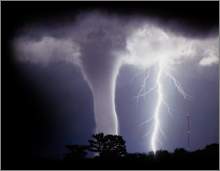|
What Every Auto and Home
Emergency Kit Should Contain
by www.SixWise.com
Emergencies can happen at any time, and they usually strike
completely without warning. Natural
disasters, terrorist attacks, car troubles, explosions
and other catastrophes are the last thing you probably want
to think about, but not thinking about the unexpected could
put you and your family in danger.
|

In the event of a natural disaster or other crisis,
your emergency kit should at least provide for your
most basic needs: food, water, warmth, and clean air
(using a dust mask or even old t-shirt).
|
Emergencies often sweep you up in chaos and panic. What is
needed during this time are the basic essentials of survival
… is your family prepared for such an occasion?
If not, NOW is the time to prepare an emergency kit for your
home and your car. It may take a few errands to collect all
of the essentials, but who can put a price on your family's
security?
Preparing an Emergency Kit for Your Home
Every family should keep the basics necessary for at least
three days of survival (for each family member and pet) on
hand at all times. The U.S. Department of Homeland Security
recommends including the following items in your kit:
-
Water: Plan on one gallon of water, per person per day, plus extra for pets
-
Food: Stock at least a three-day supply of non-perishable
food for each family member and pet (along with paper
plates, cups and utensils). Good suggestions include ready-to-eat
canned meals, meats, fruits and vegetables, canned juices
and high-energy foods like granola bars, energy bars and
nuts.
-
Battery-powered radio and extra batteries: To hear emergency
instructions and news updates
|

If you have pets, remember to include extra food and
water for them in your emergency kit.
|
-
Flashlight and extra batteries
-
First-aid kit
-
Whistle: To signal for help
-
Dust mask or cotton t-shirt: In the event air is contaminated,
you can place it over your nose and mouth to help filter
the air
-
Moist towelettes: For sanitation
-
Wrench or pliers: To turn off utilities
-
Can opener: To open canned foods
-
Plastic sheeting and duct tape: To "seal" your
room by taping windows and other outlets closed if outside
air is contaminated
-
Other family necessities: This could include prescription
medications, infant formula, diapers, important family
documents, etc.
-
Garbage bags and plastic ties: For personal sanitation
-
Household chlorine bleach and a medicine dropper: You
can use 16 drops of regular bleach to one gallon of water
to treat water supplies in an emergency
-
Extra blankets if you live in a cold climate
Preparing an Emergency Kit for Your Car
In the event your
car breaks down and you become stranded, here are the
essentials you should keep in your car's emergency kit:
-
A flashlight, flares and a first-aid kit
-
Jumper cables, a tool kit and tire chains
-
A blanket and some warm winter clothes (in cold climates)
-
A bag of sand or salt, to use for traction if a tire
gets stuck
-
A snowbrush, ice scraper and snow shovel (in cold climates)
-
A container of wiper fluid and paper towels
-
Some non-perishable food and water
Put your emergency supplies into one consolidated container
or even a couple of backpacks. Then, store your emergency
kits in an easy-to-find location in your home and vehicle,
and make sure that every family member knows where to find
them.
While you can't predict if and when a disaster may strike,
you can give yourself peace of mind that you'll be well prepared.
Recommended Reading
If
Natural or Terrorist Disaster Occurs, Do You Have a Family
Plan? (Download Your FREE Planner Now)
Flooding:
How to Best Prepare Your Home for It, and How to Respond to
It If Floods Have Already Hit
Sources
Ready.gov
Redcross.org
|